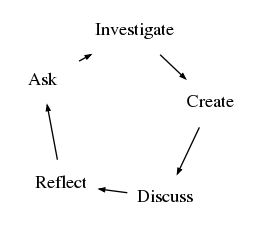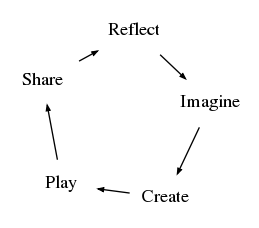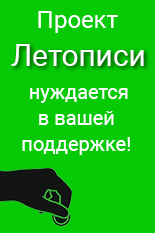Reseach based on Special:Log/Introduction/Types
Конструкционизм и различные типы конструктивной деятельности и их различные реализации, но педагогический дизайн во всех направлениях конструкционизма направлен на создание системы, которая вовлекала бы учеников в использование объектов и средств, помогающих думать новым способом или как писал Кей - непривычные способы мышления.
Типология разных способов организации деятельности. Есть несколько оснований, почему сообщества используют метафору цикла и простые глаголы действий:
- Исходный базовый цикл исследовательской деятельности, предложенный Брунером
- Подходы к применению Лого и NetLogo в IBL - а их много - ученик экспериментирует с моделями, работает с проблемами, ставит эксперименты, получает результаты, уточняет гипотезу и ставит новые эксперименты. Это объединение простых операций, из которых при массовом соблюдении правил вырастают сложные паттерны поведения - проще всего наблюдать на примере известных моделей - поведения термитов, собирающих палочки в кучки или птиц, постепенно объединяющихся в стаи.
- Социальный объект и дизайн, основанный на объектной социальности
Содержание |
IBL cycle
Базовый цикл исследовательской деятельности inquiry-based learning
Ask -> Investigate -> Create -> Discuss -> Reflect -> Ask

Globaloria cycle
Цикл создания компьютерных игр и моделей в проекты Глобалория в основании которых работы Харел и ее группы,
Play -> Plan -> Prototype -> Program -> Publish -> Play

Participate: Use the Globaloria Social Learning Network to work in teams, learn to solve programming problems and share computational knowledge publicly. Learn to collaborate onsite with classmates and educators, as well as virtually with students in other schools, and professional game makers and programmers.
- Play: Play to discover what makes a great educational game. Learn about game mechanics, simulations, genres, and design principles. Get inspired!
- Plan: Decide who the audience is and what your game is going to do. Research learning topics and learn your game content. Organize your ideas in a written plan. Keep adding to the plan as your research and design develops.
- Prototype: Draw and videotape your game concept and test your prototype with users. Learn to use Flash to create an interactive demo that shows how the game will look.
- Program: Write the code for your game in Flash ActionScript. Learn to program, test, and get help from experts using tutorials and virtual network for communication.
- Publish: Learn how to present and publish designs, code, and games online.
- Reynolds R., Caperton I.H. Comparison of Middle School, High School and Community College Students’ Wiki Activity in Globaloria-West Virginia: (Pilot Year-two) // Proceedings of the 5th International Symposium on Wikis and Open Collaboration WikiSym ’09. New York, NY, USA: ACM, 2009. С. 29:1–29:2.
Scratch cycle - kindergarten approach to learning
This paper argues that the “kindergarten approach to learning” – characterized by a spiraling cycle of Imagine, Create, Play, Share, Reflect, and back to Imagine – is ideally suited to the needs of the 21st century, helping learners develop the creative-thinking skills that are critical to success and satisfaction in today’s society.
- Resnick M. All I Really Need to Know (About Creative Thinking) I Learned (by Studying How Children Learn) in Kindergarten // Proceedings of the 6th ACM SIGCHI Conference on Creativity & Cognition C&C ’07. New York, NY, USA: ACM, 2007. С. 1–6.
- What do I mean by the kindergarten approach to learning? In traditional kindergartens, children are constantly designing, creating, experimenting, and exploring. Two children might start playing with wooden blocks; over time, they build a collection of towers. A classmate sees the towers and starts pushing his toy car between them. But the towers are too close together, so the children start moving the towers further apart to make room for the cars. In the process, one of the towers falls down. After a brief argument over who was at fault, they start talking about how to build a taller and stronger tower. The teacher shows them pictures of real-world skyscrapers, and they notice that the bottoms of the buildings are wider than the tops. So they decide to rebuild their block tower with a wider base than before.
- This type of process is repeated over and over in kindergarten. The materials vary (finger paint, crayons, bells) and the creations vary (pictures, stories, songs), but the core process is the same. I think of it as a spiraling process in which children imagine what they want to do, create a project based on their ideas, play with their creations, share their ideas and creations with others, reflect on their experiences – all of which leads them to imagine new ideas and new projects.
Imagine -> Create -> Play -> Share -> Reflect -> Imagine
Придумай, что хочешь сделать -> Создай проект на основе придуманного -> Поиграй с тем, что ты придумал -> Поделись своими идеями и проектами -> Обдумай свой опыт и опыт других -> Придумай новые идеи и новые проекты

и реализуемые на этой спирали проекты Scratch, основанные на работах Резника. Близкие ветви этого же куста - NetLogo, StarLogo TNG,
StarLogo cycle - combining games and science
У Клопфера этот цикл явно в 2-х пересекающихся кластерах. Это в нем и интересно, потому что мы потом сможем такую же комбинацию построить для исследования и сторителлинга в летописи.
Observe/Collect Data -> Generate Questions -> Test/Tinker/Play -> Observe/Collect Data
Design -> Build -> Test/Tinker/Play -> Design
- Klopfer E. и др. The Simulation Cycle: Combining Games, Simulations, Engineering and Science Using StarLogo TNG // E-Learning and Digital Media. 2009. Т. 6. № 1. С. 71–96. - http://ldm.sagepub.com/content/6/1/71.full.pdf+html
- Klopfer E., Scheintaub H. StarLogo TNG: Science in Student-programmed Simulations // Proceedings of the 8th International Conference on International Conference for the Learning Sciences - Volume 3 ICLS’08. Utrecht, The Netherlands: International Society of the Learning Sciences, 2008. С. 59–60.

И здесь сходство и в базовых представлениях и в том, что внутри - сама среда устроена так, что происходит объединение простых операций, на базе которых формируется сложное поведение. Резник об этом писал - Думать как дерево.
Что объединяет все представленные выше циклы или спирали деятельности? Это объединение простых операций, из которых при массовом соблюдении правил вырастают сложные паттерны поведения - проще всего наблюдать на примере известных моделей - поведения термитов, собирающих палочки в кучки или птиц, постепенно объединяющихся в стаи.
CloudWorks
- Conole G., Culver J. Cloudworks: Social networking for learning design // Australasian Journal of Educational Technology. 2009. Т. 25. № 5. С. 763–782.
- Galley R. и др. Cloudworks as a ‘pedagogical wrapper’ for LAMS sequences: supporting the sharing of ideas across professional boundaries and facilitating collaborative design, evaluation and critical reflection. Oxford: , 2010.
- Galley, Rebecca, Grainne Conole, James Dalziel, and Ernie Ghiglione 2010 Cloudworks as a “pedagogical Wrapper” for LAMS Sequences: Supporting the Sharing of Ideas across Professional Boundaries and Facilitating Collaborative Design, Evaluation and Critical Reflection. In . Oxford. http://oro.open.ac.uk/22328/, accessed July 22, 2016.
Cloudworks is a social networking site for learning design, which aims to utilise Web 2.0 based practices in an educational context. The aim is to create an evolving, dynamic community for sharing of learning and teaching ideas and design. The site is based on the notion of ‘social objects’ (Engestrom, 2005).
The core object in Cloudworks is a ‘cloud’. A cloud can be anything to do with learning and teaching – a description of a teaching session, ideas for promoting a particular form of learning, details about specific learning and teaching tools or resources. The site is designed to facilitate connections between these objects; to enable users to discuss them (i.e. they are social objects) and to cumulatively and collectively improve them (through additional content, links and academic references).
На самом деле описание A cloud can be anything to do with learning and teaching - очень неудачное описание объекта, а реально этим объектом для сайта является сценарий учебной деятельности, выполненный при помощи Compendium Learning Design
Общий конструкционистский подход, когда социальная сеть выстраивается вокруг объектов, которые создают и которыми обмениваются участники. Social object - социальный объект
We believe that having a social, object based approach is key to ensuring that the site remains active, dynamic and user driven. We have reviewed the lessons learnt from pervious attempts to create sustainable learning and teaching communities - both from initiatives within education (for example the creation of learning object and OER repositories), as well as the more general patterns of user behaviour evident from generic web services. We are using this understanding of what worked and what didn’t work as the basis for guiding our design approach. We draw in particular on the work of Engeström (2005) in terms of the concept of “social objects” and his arguments for the importance of social objects as the key mediating artefacts (Conole, 2008a) that make social networks work. More broadly we draw on the work of Bouman et al. (2007); in terms of understanding current and evolving users practices and how websites can be designed to enable changes in practice.
- https://edugalaxy.intel.ru/index.php?automodule=blog&blogid=11&showentry=6450
- http://edutechwiki.unige.ch/en/Cloudworks
WebGrid
Социальная сеть, основанная на создании и изучении моделей персональных концепций, выявляемых по методу репертуарных решеток Келли
- Gaines B.R., Shaw M.L.G. Concept maps as hypermedia components // International Journal of Human-Computer Studies. 1995. Т. 43. № 3. С. 323–361.
- Gaines B.R., Shaw M.L.G. Sociocognitive Inquiry // Social Network Mining, Analysis, and Research Trends: Techniques and Applications / под ред. I.-H. Ting, T.-P. Hong, L.S.-L. Wang. : IGI Global, 2012. С. 35–55.
Использовали точно такой же подход, основанный на совместной деятельности с социальными объектами
WebGrid is a conceptual representation system that elicits and analyzes your personal models of an area of experience that you specify. You may add, delete, edit or sort properties You can view and interpret your grid content in different ways
WebGrid is a web-based conceptual modeling service based on Kelly’s conceptual grids derived from personal construct psychology. The tools readily integrate with survey methodologies and have the merit of proving instant online conceptual models in graphic form enabling participants to view their own models and compare them with those of others in the community, together with overall socionets of cognitive relations between members, and consolidated conceptual models that show the sociocognitive structure of the community.
Rep 5 (Gaines & Shaw, 2009), the suite of conceptual modeling tools of which WebGrid is part, also contains RepSocio, a tool for analyzing multiple grids. Pairwise comparison of a set of grids results in a weighted directed graph. We term the graph a sociocognitive network rather than a social network because it represents the shared meanings between participants in a social network rather than their behavioral interactions. Sociocognitive network models provides additional information to behavioral studies and, together, the two types of structure provide a multi-dimensional model. RepSocio can also provide a consensual conceptual model for the entire community using a Procrustes analysis technique (Gower & Dijksterhuis, 2004) where everyone’s constructs are ranked in terms of the average best match in all other grids. The top ranked constructs are then combined in a conceptual grid that models the distinctions common across the community, termed a mode or consensus grid (Shaw, 1980).
- Gaines B.R., Shaw M.L.G. Sociocognitive Inquiry // Social Network Mining, Analysis, and Research Trends: Techniques and Applications / под ред. I.-H. Ting, T.-P. Hong, L.S.-L. Wang. : IGI Global, 2012. С. 35–55.
- Patarakin E., Travina L., Kelly's RG Test in Education. Play with results. Media and telematica Technologies for Education in Eastern European Countries/ Ed. by Piet Kommers and other, Twente University Press, Enschede, 1997, p. 309 - 312.
В качестве социального объекта используется решетка (grid) с которой участник user может совершать различные действия:
Display -> Cluster -> Map -> Crossplot -> Matches -> Compare
George Kelly (1955) developed what he termed conceptual grids as a method of representing a person’s conceptual model of a domain by eliciting the bipolar constructs through which they differentiated significant elements in that domain. His primary interest was clinical psychology and he developed a particular form of the grid to model a clients’ models of their immediate social world in which people were significant to them in a variety of roles. He termed this a role repertory grid, often abbreviated to repertory grid or repgrid. In much of the personal construct psychology literature these terms became used more generally to describe Kelly’s generic “conceptual grid.”
NetLogo Modeling Commons
The Modeling Commons is for sharing and discussing agent-based models written in NetLogo. With more than 1,000 models, contributed by modelers from around the world, you're bound to learn something new.
The Modeling Commons makes it possible for NetLogo modelers to share their work with others via a central Web site. The author of a model may optionally allow others to edit and update the model, providing a mechanism for collaborative modeling. Users may attach one or more supporting files to a model, such as input data, curricular suggestions, research papers, and PowerPoint presentations. Those users who visit the model in the Modeling Commons may participate in a discussion about the model, apply one or more social tags to it, or recommend it to their friends. Anecdotal evidence indicates that many NetLogo users already share models with one another, and even collaborate with their peers while modeling. However, we believe that such interactions are less frequent than could be if collaborative tools were more easily accessible.
- R. M. Lerner, «Agent-Based Modeling as a Social Activity», NORTHWESTERN UNIVERSITY, 2014.
